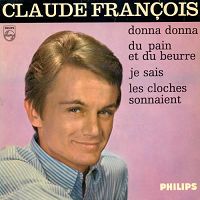Donna Donna
| "Dana Dana (Yiddish original)" |
|
|---|---|
| Song | |
| Published | 1941 |
| Writer(s) | Sholom Secunda, Aaron Zeitlin |
| Language | Yiddish |
| "Dona Dona (English version)" |
|
|---|---|
| Song | |
| Published | mid-1950s |
| Genre | Folk music |
| Writer(s) | Sholom Secunda, Aaron Zeitlin. English lyrics by Arthur Kevess and Teddi Schwartz |
| Language | English |
| "Donna Donna" | |
|---|---|
| Single by Joan Baez | |
| from the album Joan Baez | |
| A-side | House of the Rising Sun |
| B-side | Donna, Donna |
| Released | 1960 |
| Recorded | 1960 |
| Genre | Folk music |
| Length | 3:15 or 3:09 |
| Label | Vanguard |
| Writer(s) | English lyrics by Arthur Kevess and Teddi Schwartz |
| "Donna Donna" | |
|---|---|
 |
|
| Single by Claude François | |
| from the album Donna Donna / Les choses de la maison | |
| A-side | Donna, Donna |
| B-side | Du Pain et du beurre / Je sais / Les cloches sonnaient |
| Released | 1964-1965 |
| Recorded | 1964 |
| Genre | Folk music |
| Length | 2:32 |
| Label | Philips |
| Writer(s) | French lyrics by Vline Buggy, Claude François |
| "Donna Donna" | |
|---|---|
 |
|
| Single by Donovan | |
| from the album What's Bin Did and What's Bin Hid | |
| A-side | Donna, Donna |
| B-side | Car Car / (alternatively) Josie |
| Released | 1965 |
| Recorded | 1965 |
| Genre | Folk music |
| Length | 2:56 |
| "Donna Donna" | |
|---|---|
 |
|
| Single by C4 | |
| A-side | Donna, Donna |
| Released | 1998 |
| Recorded | 1998 |
| Genre | Dance music / disco |
| Length | 3:31 |
| Writer(s) | French lyrics by Vline Buggy, Claude François |
"Dona Dona" popularly known as "Donna, Donna" is a song about a calf being led to slaughter written by Sholom Secunda and Aaron Zeitlin. Originally a Yiddish language song "Dana Dana" (in Yiddish דאַנאַ דאַנאַ), also known as "Dos Kelbl" (in Yiddish דאָס קעלבל meaning The Calf) it was a song used in a Yiddish play produced by Zeitlin. In Hebrew, it is known as "Lama Dona".
"Dana Dana" was written for the Aaron Zeitlin stage production Esterke (1940–41) with music composed by Sholom Secunda. The lyrics, score, parts, and associated material are available online in the Yiddish Theater Digital Archives. The lyric sheet is in typewritten Yiddish and handwritten Yiddish lyrics also appear in the piano score. The text underlay in the score and parts is otherwise romanized in a phonetic transcription that appears oriented toward stage German. The YIVO standardized transliteration system was not then in widespread use, and many Yiddish transliterations looked like German, to which the Yiddish language is closely related.
The orchestra plays the "Dana Dana" melody at several points in Esterke. The original is 2/4, in G minor for a duo of a man and a woman, choral with the orchestral accompaniment. Secunda wrote "Dana-" for the orchestral score and "Dana Dana" for the vocal scores. The Yiddish text was written with Roman alphabet. He wrote for the choral score "andantino" (somewhat slowly) and "sempre staccato" (play staccato always). The melody of the introduction was also used at the end of the song. He wrote "piu mosso" (more rapidly) for the refrain and some passages that emphasize the winds. First, a woman (Secunda wrote "she") sings four bars and then the man (Secunda wrote "he") sings the next four. They sing together from the refrain. Although singing the third part of "Dana Dana" (="Dana Dana Dana Dana...") the man sometimes sings lower than the melody using disjunct motions. The melody is refrained. Then "he" sings the melody, and "she" sometimes sings "Dana", other times sings "Ah" with a high voice or technical passage. Secunda wrote "molto rit." (suddenly much more slowly) for the ending of the first verse. There are some differences between the original and the melody that are well known. Secunda wrote "ha ha ha" for the choral score with the broken chords.
Secunda translated "Dana Dana" into English language (changing the vocalization of 'dana' to 'dona'), but this version didn't gain much attention.
...
Wikipedia
